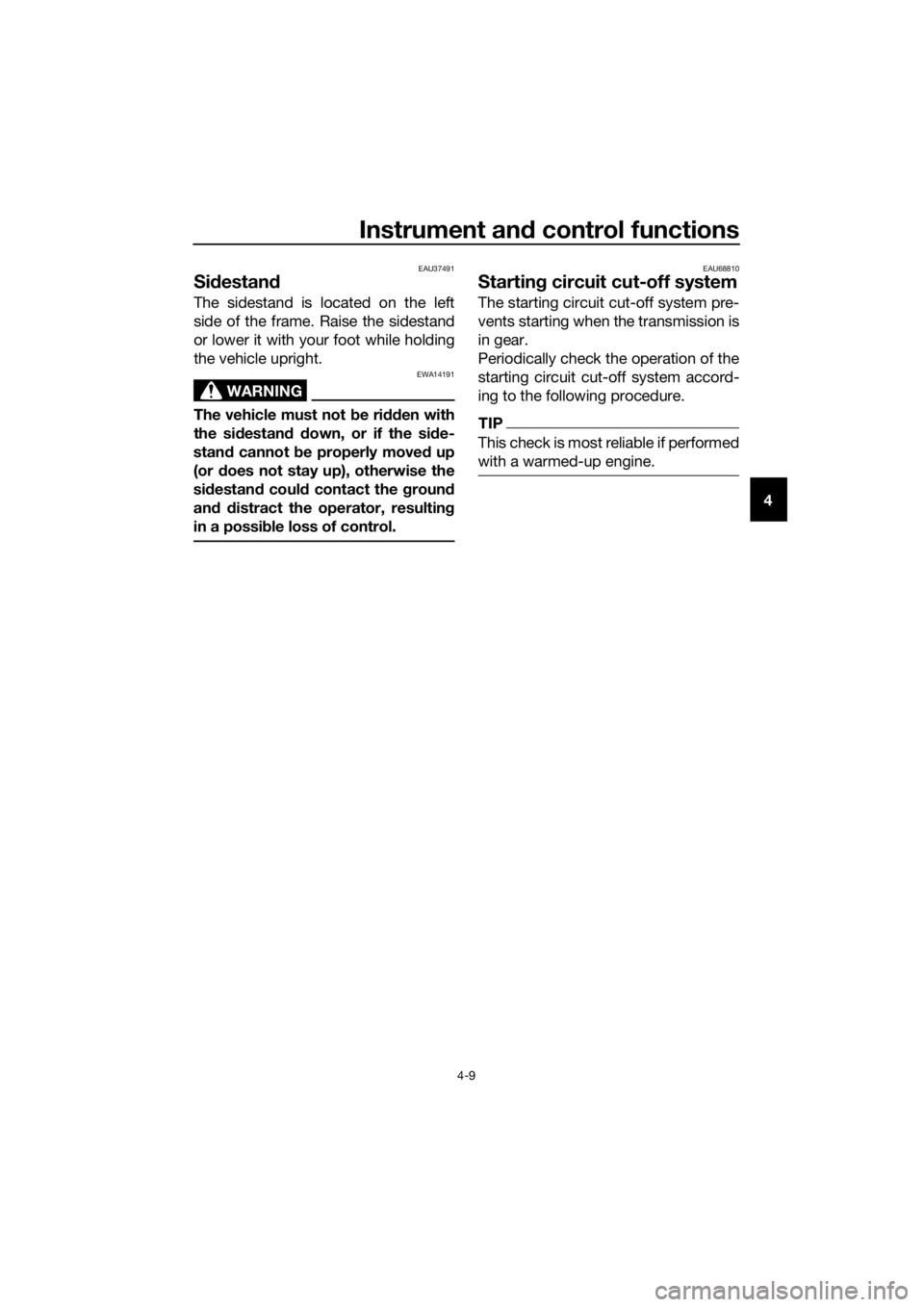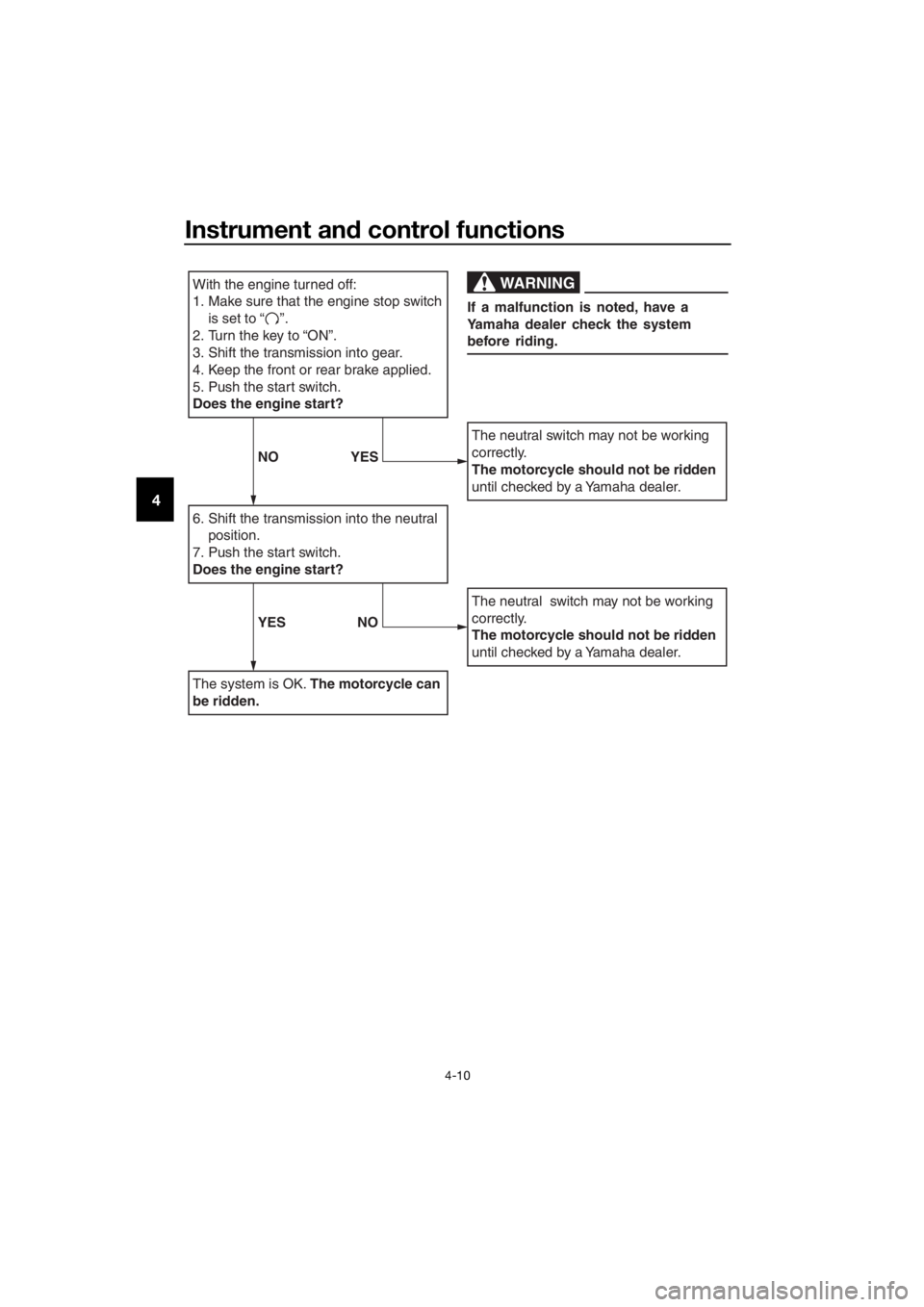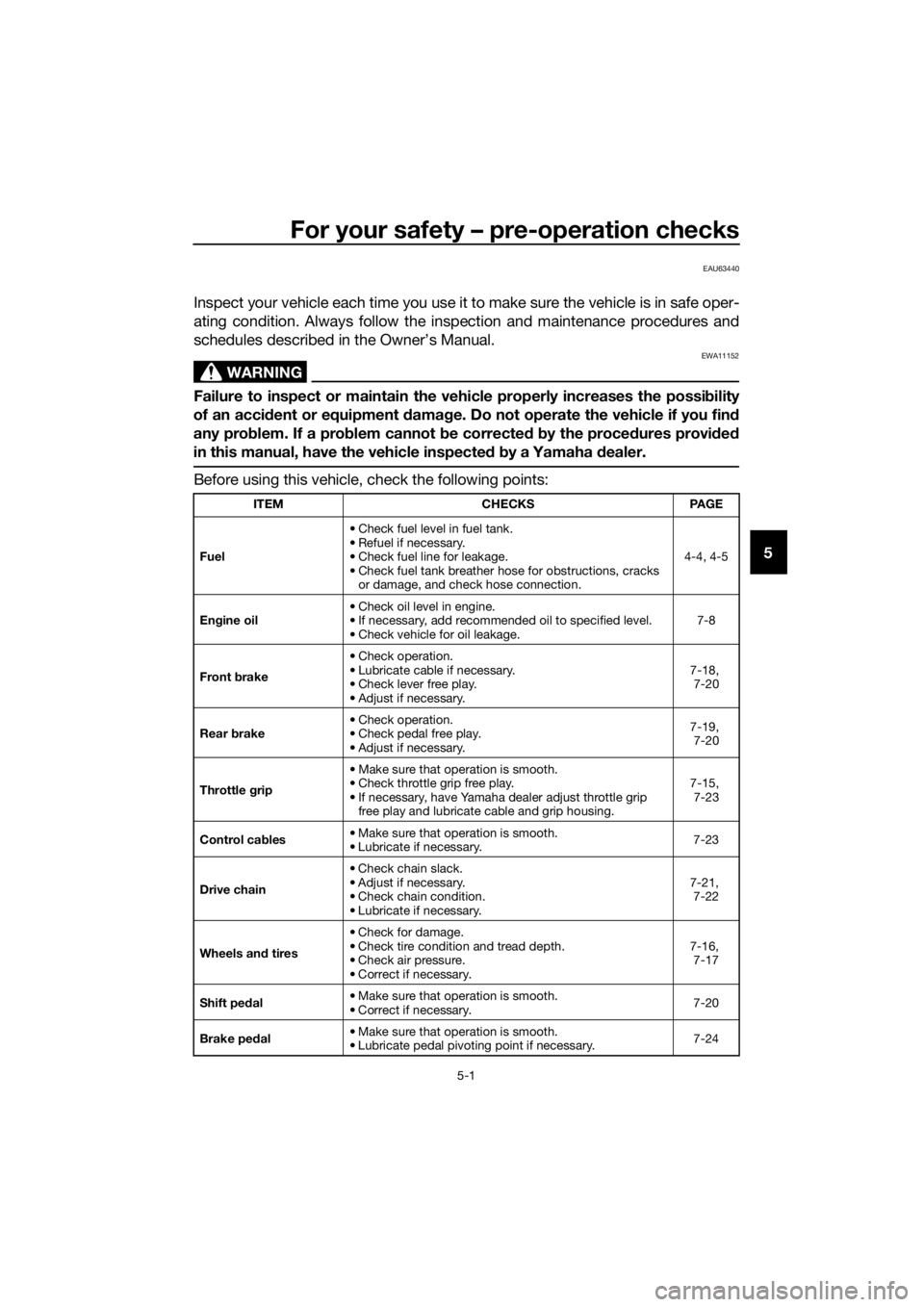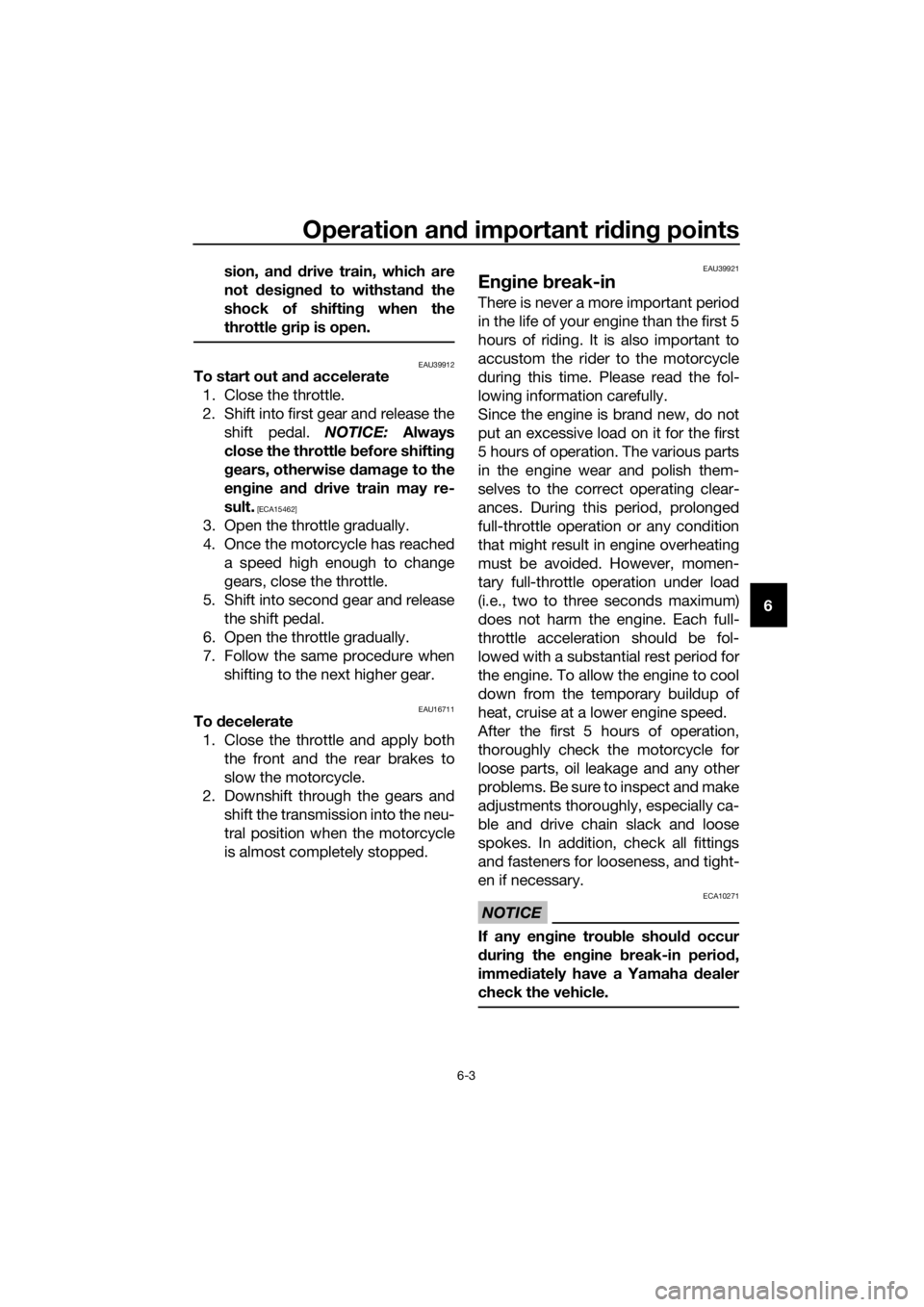check engine YAMAHA TT-R110E 2021 Owners Manual
[x] Cancel search | Manufacturer: YAMAHA, Model Year: 2021, Model line: TT-R110E, Model: YAMAHA TT-R110E 2021Pages: 90, PDF Size: 2.16 MB
Page 8 of 90

Table of contents
Location of important la bels ........... 1-1
Safety information ............................ 2-1
Description ....................................... 3-1
Left view ......................................... 3-1
Right view ....................................... 3-2
Controls and instruments ............... 3-3
Instrument an d control functions ... 4-1
Main switch .................................... 4-1
Handlebar switches ........................ 4-1
Shift pedal ...................................... 4-2
Brake lever...................................... 4-2
Brake pedal .................................... 4-3
Fuel tank cap .................................. 4-3
Fuel ................................................. 4-4
Fuel tank breather hose.................. 4-5
Fuel cock ........................................ 4-6
Starter (choke) lever ...................... 4-7
Kickstarter ..................................... 4-7
Seat ................................................ 4-8
Shock absorber assembly .............. 4-8
Sidestand ....................................... 4-9
Starting circuit cut-off system ........ 4-9
For your safety – pre-operation
checks ............................................... 5-1
Operation an d important ri din g
points ................................................ 6-1
Starting and warming up a cold
engine ......................................... 6-1
Starting a warm engine .................. 6-2
Shifting ........................................... 6-2
Engine break-in .............................. 6-3
Parking ........................................... 6-4
Perio dic maintenance an d
a d justment ........................................ 7-1
Owner’s tool kit .............................. 7-2
Periodic maintenance chart for the
emission control system ............. 7-3
General maintenance and lubrication chart .......................... 7-4
Removing and installing panels...... 7-6 Checking the spark plug ................. 7-7
Engine oil......................................... 7-8
Cleaning the air filter element ....... 7-10
Cleaning the spark arrester ........... 7-12
Adjusting the carburetor ............... 7-13
Adjusting the engine idling
speed ......................................... 7-14
Checking the throttle grip free
play ............................................ 7-15
Valve clearance ............................. 7-15
Tires .............................................. 7-16
Spoke wheels ................................ 7-17
Adjusting the clutch free play........ 7-18
Adjusting the brake lever free play ............................................ 7-18
Adjusting the brake pedal free play ............................................ 7-19
Checking the shift pedal ............... 7-20
Checking the front and rear brake shoes ......................................... 7-20
Drive chain slack ........................... 7-21
Cleaning and lubricating the drive chain ................................. 7-22
Checking and lubricating the cables ........................................ 7-23
Checking and lubricating the
throttle grip and cable ............... 7-23
Checking and lubricating the brake lever ................................. 7-24
Checking and lubricating the brake pedal ................................ 7-24
Checking and lubricating the
sidestand ................................... 7-25
Lubricating the swingarm pivots ... 7-25
Checking the front fork ................. 7-26
Checking the steering ................... 7-26
Checking the wheel bearings ........ 7-27
Battery........................................... 7-27
Replacing the fuse ........................ 7-29
Supporting the motorcycle ........... 7-29
Front wheel ................................... 7-30
Rear wheel .................................... 7-31
Troubleshooting ............................ 7-33
Troubleshooting chart ................... 7-34
UB5186E0.book Page 1 Wednesday, April 22, 2020 9:11 AM
Page 21 of 90

Safety information
2-3
2
ventilated areas. If you experience any
symptoms of carbon monoxide poi-
soning, leave the area immediately, get
fresh air, and SEEK MEDICAL TREAT-
MENT.
Do not run engine indoors. Even if
you try to ventilate engine exhaust
with fans or open windows and
doors, carbon monoxide can rap-
idly reach dangerous levels.
Do not run engine in poorly venti-
lated or partially enclosed areas
such as barns, garages, or car-
ports.
Do not run engine outdoors where
engine exhaust can be drawn into
a building through openings such
as windows and doors.
Loa din g
Adding accessories to your motorcycle
can adversely affect stability and han-
dling if the weight distribution of the
motorcycle is changed. To avoid the
possibility of an accident, use extreme
caution when adding accessories to
your motorcycle. Use extra care when
riding a motorcycle that has added ac-
cessories. Here are some general
guidelines to follow if adding accesso-
ries to your motorcycle:
Operation of an overload ed vehicle
coul d cause an acci dent.
The weight of the operator must
not exceed 60.0 kg (132 lb).
Accessory weight should be kept
as low and close to the motorcy-
cle as possible. Securely pack
your heaviest items as close to the
center of the vehicle as possible
and make sure to distribute the weight as evenly as possible on
both sides of the motorcycle to
minimize imbalance or instability.
Shifting weights can create a sud-
den imbalance. Make sure that
accessories are securely attached
to the motorcycle before riding.
Check accessory mounts fre-
quently.
• Properly adjust the suspension for your load (suspension-ad-
justable models only), and
check the condition and pres-
sure of your tires.
• Never attach any large or heavy items to the handlebar, front
fork, or front fender.
Genuine Yamaha Accessories
Choosing accessories for your vehicle
is an important decision. Genuine
Yamaha accessories, which are avail- able only from a Yamaha dealer, have
been designed, tested, and approved
by Yamaha for use on your vehicle.
Many companies with no connection
to Yamaha manufacture parts and ac-
cessories or offer other modifications
for Yamaha vehicles. Yamaha is not in
a position to test the products that
these aftermarket companies produce.
Therefore, Yamaha can neither en-
dorse nor recommend the use of ac-
cessories not sold by Yamaha or
modifications not specifically recom-
mended by Yamaha, even if sold and
installed by a Yamaha dealer.
UB5186E0.book Page 3 Wednesday, April 22, 2020 9:11 AM
Page 22 of 90

Safety information
2-4
2Aftermarket Parts, Accessories, an
d
Mo difications
While you may find aftermarket prod-
ucts similar in design and quality to
genuine Yamaha accessories, recog-
nize that some aftermarket accesso-
ries or modifications are not suitable
because of potential safety hazards to
you or others. Installing aftermarket
products or having other modifications
performed to your vehicle that change
any of the vehicle’s design or operation
characteristics can put you and others
at greater risk of serious injury or
death. You are responsible for injuries
related to changes in the vehicle.
Keep the following guidelines in mind,
as well as those provided under “Load-
ing” when mounting accessories. Never install accessories that
would impair the performance of
your motorcycle. Carefully inspect
the accessory before using it to
make sure that it does not in any
way reduce ground clearance or
cornering clearance, limit suspen-
sion travel, steering travel or con-
trol operation.
• Accessories fitted to the han- dlebar or the front fork area can
create instability due to improp-
er weight distribution. If acces-
sories are added to the
handlebar or front fork area,
they must be as lightweight as
possible and should be kept to
a minimum.
• Bulky or large accessories may seriously affect the stability of
the motorcycle. Wind may at- tempt to lift the motorcycle, or
the motorcycle may become
unstable in cross winds.
• Certain accessories can dis- place the operator from his or
her normal riding position. This
improper position limits the
freedom of movement of the
operator and may limit control
ability, therefore, such accesso-
ries are not recommended.
Use caution when adding electri-
cal accessories. If electrical ac-
cessories exceed the capacity of
the motorcycle’s electrical sys-
tem, an electric failure could re-
sult, which could cause a
dangerous loss of lights or engine
power.
Aftermarket Tires an d Rims
The tires and rims that came with your
motorcycle were designed to match
the performance capabilities and to
provide the best combination of han-
dling, braking, and comfort. Other
tires, rims, sizes, and combinations
may not be appropriate. Refer to page
7-16 for tire specifications and more in-
formation on replacing your tires.
Transportin g the Motorcycle
Be sure to observe following instruc-
tions before transporting the motorcy-
cle in another vehicle. Remove all loose items from the
motorcycle.
Check that the fuel cock (if
equipped) is in the “OFF” position
and that there are no fuel leaks.
UB5186E0.book Page 4 Wednesday, April 22, 2020 9:11 AM
Page 35 of 90

Instrument and control functions
4-9
4
EAU37491
Si destan d
The sidestand is located on the left
side of the frame. Raise the sidestand
or lower it with your foot while holding
the vehicle upright.
WARNING
EWA14191
The vehicle must not be ri dden with
the si destan d d own, or if the si de-
stan d cannot b e properly move d up
(or does not stay up), otherwise the
si destan d coul d contact the g round
an d d istract the operator, resultin g
in a possi ble loss of control.
EAU68810
Startin g circuit cut-off system
The starting circuit cut-off system pre-
vents starting when the transmission is
in gear.
Periodically check the operation of the
starting circuit cut-off system accord-
ing to the following procedure.
TIP
This check is most reliable if performed
with a warmed-up engine.
UB5186E0.book Page 9 Wednesday, April 22, 2020 9:11 AM
Page 36 of 90

Instrument and control functions
4-10
4
With the engine turned off:
1. Make sure that the engine stop switch
is set to “ ”.
2.
Turn the key to “ON”.
3. Shift the transmission into gear.
5. Push the start switch. 4. Keep the front or rear brake applied.
Does the engine start?
6. Shift the transmission into the neutral position.
7. Push the start switch.
Does the engine start?
The system is OK. The motorcycle can
be ridden.
The neutral switch may not be working
correctly.
The motorcycle should not be ridden
until checked by a Yamaha dealer.
The neutral switch may not be working
correctly.
The motorcycle should not be ridden
until checked by a Yamaha dealer.
WARNING
If a malfunction is noted, have a
Yamaha dealer check the system
before riding.
NO YES
YES NO
UB5186E0.book Page 10 Wednesday, April 22, 2020 9:11 AM
Page 37 of 90

For your safety – pre-operation checks
5-1
5
EAU63440
Inspect your vehicle each time you use it to make sure the vehicle is in safe oper-
ating condition. Always follow the inspection and maintenance procedures and
schedules described in the Owner’s Manual.
WARNING
EWA11152
Failure to inspect or maintain the vehicle properly increases the possibility
of an acci dent or equipment d amage. Do not operate the vehicle if you fin d
any prob lem. If a pro blem cannot be corrected b y the proce dures provi ded
in this manual, have the vehicle inspecte d b y a Yamaha d ealer.
Before using this vehicle, check the following points:
ITEM CHECKSPAGE
Fuel • Check fuel level in fuel tank.
• Refuel if necessary.
• Check fuel line for leakage.
• Check fuel tank breather hose for obstructions, cracks
or damage, and check hose connection. 4-4, 4-5
En gine oil • Check oil level in engine.
• If necessary, add recommended oil to specified level.
• Check vehicle for oil leakage. 7-8
Front brake • Check operation.
• Lubricate cable if necessary.
• Check lever free play.
• Adjust if necessary. 7-18,
7-20
Rear brake • Check operation.
• Check pedal free play.
• Adjust if necessary. 7-19,
7-20
Throttle g rip • Make sure that operation is smooth.
• Check throttle grip free play.
• If necessary, have Yamaha dealer adjust throttle grip
free play and lubricate cable and grip housing. 7-15,
7-23
Control ca bles • Make sure that operation is smooth.
• Lubricate if necessary. 7-23
Drive chain • Check chain slack.
• Adjust if necessary.
• Check chain condition.
• Lubricate if necessary. 7-21,
7-22
Wheels an d tires •Check for damage.
• Check tire condition and tread depth.
• Check air pressure.
• Correct if necessary. 7-16,
7-17
Shift ped al • Make sure that operation is smooth.
• Correct if necessary. 7-20
Brake ped al • Make sure that operation is smooth.
• Lubricate pedal pivoting point if necessary.
7-24
UB5186E0.book Page 1 Wednesday, April 22, 2020 9:11 AM
Page 41 of 90

Operation and important ri din g points
6-3
6
sion, an
d d rive train, which are
not desi gne d to withstand the
shock of shiftin g when the
throttle grip is open.
EAU39912To start out an d accelerate
1. Close the throttle.
2. Shift into first gear and release the shift pedal. NOTICE: Always
close the throttle before shiftin g
g ears, otherwise damag e to the
en gine an d d rive train may re-
sult.
[ECA15462]
3. Open the throttle gradually.
4. Once the motorcycle has reached a speed high enough to change
gears, close the throttle.
5. Shift into second gear and release the shift pedal.
6. Open the throttle gradually.
7. Follow the same procedure when shifting to the next higher gear.
EAU16711To decelerate
1. Close the throttle and apply both the front and the rear brakes to
slow the motorcycle.
2. Downshift through the gears and shift the transmission into the neu-
tral position when the motorcycle
is almost completely stopped.
EAU39921
Engine break-in
There is never a more important period
in the life of your engine than the first 5
hours of riding. It is also important to
accustom the rider to the motorcycle
during this time. Please read the fol-
lowing information carefully.
Since the engine is brand new, do not
put an excessive load on it for the first
5 hours of operation. The various parts
in the engine wear and polish them-
selves to the correct operating clear-
ances. During this period, prolonged
full-throttle operation or any condition
that might result in engine overheating
must be avoided. However, momen-
tary full-throttle operation under load
(i.e., two to three seconds maximum)
does not harm the engine. Each full-
throttle acceleration should be fol-
lowed with a substantial rest period for
the engine. To allow the engine to cool
down from the temporary buildup of
heat, cruise at a lower engine speed.
After the first 5 hours of operation,
thoroughly check the motorcycle for
loose parts, oil leakage and any other
problems. Be sure to inspect and make
adjustments thoroughly, especially ca-
ble and drive chain slack and loose
spokes. In addition, check all fittings
and fasteners for looseness, and tight-
en if necessary.
NOTICE
ECA10271
If any en gine trou ble shoul d occur
d urin g the en gine break-in perio d,
imme diately have a Yamaha dealer
check the vehicle.
UB5186E0.book Page 3 Wednesday, April 22, 2020 9:11 AM
Page 45 of 90

Periodic maintenance an d a djustment
7-3
7
EAU69172
Perio dic maintenance chart for the emission control system
TIP
From 7000 km (4200 mi) or 18 months, repeat the maintenance intervals
starting from 3000 km (1800 mi) or 6 months.
Items marked with an asterisk should be performed by a Yamaha dealer as
they require special tools, data and technical skills.
No. ITEM 13 5
0.6 1.8 3 16 12
30 90 150
1 *Fuel line • Check fuel hoses for cracks or
damage.
• Replace if necessary. √√
2Spark plu g• Check condition.
• Adjust gap and clean.
√√
3 *Valve clearance • Check and adjust valve clear-
ance when engine is cold. √
4 Air filter element • Clean with solvent.
• Replace if necessary.
√√
5 *Crankcase
breather
system • Check ventilation hose for
cracks or damage and drain
any deposits.
• Replace if necessary. √√ √
6 *Car buretor • Check engine idling speed and
starter operation.
• Adjust if necessary. √√ √
7 Exhaust system • Check for leakage.
• Tighten if necessary.
• Replace gasket(s) if necessary. √√
8 *Spark arrester • Clean. √
9En gine oil • Change (warm engine before
draining). √√ √X 1000 km
X 1000 mi month
CHECKS AND
MAINTENANCE JOBS
hours
INITIALODOMETER READINGS
UB5186E0.book Page 3 Wednesday, April 22, 2020 9:11 AM
Page 49 of 90

Periodic maintenance an d a djustment
7-7
7
EAU19607
Checkin g the spark plu g
The spark plug is an important engine
component, which is easy to check.
Since heat and deposits will cause any
spark plug to slowly erode, the spark
plug should be removed and checked
in accordance with the periodic main-
tenance and lubrication chart. In addi-
tion, the condition of the spark plug
can reveal the condition of the engine.
To remove the spark plu g
1. Remove the spark plug cap.
2. Remove the spark plug as shown, with the spark plug wrench includ-
ed in the owner’s tool kit. To check the spark plu
g
1. Check that the porcelain insulator around the center electrode of the
spark plug is a medium-to-light
tan (the ideal color when the vehi-
cle is ridden normally).
TIP
If the spark plug shows a distinctly dif-
ferent color, the engine could be oper-
ating improperly. Do not attempt to
diagnose such problems yourself. In-
stead, have a Yamaha dealer check
the vehicle.
2. Check the spark plug for electrodeerosion and excessive carbon or
other deposits, and replace it if
necessary.
3. Measure the spark plug gap with a wire thickness gauge and, if nec-
essary, adjust the gap to specifi-
cation.
1. Spark plug cap
1. Spark plug wrench
1
1
Specified spark plu g:
NGK/CR6HSA
1. Spark plug gap
Spark plu g g ap:
0.6–0.7 mm (0.024–0.028 in)
UB5186E0.book Page 7 Wednesday, April 22, 2020 9:11 AM
Page 50 of 90

Periodic maintenance an d a djustment
7-8
7 To install the spark plu
g
1. Clean the surface of the spark plug gasket and its mating surfa-
ce, and then wipe off any grime
from the spark plug threads.
2. Install the spark plug with the spark plug wrench, and then tight-
en it to the specified torque.
TIP
If a torque wrench is not available
when installing a spark plug, a good
estimate of the correct torque is 1/4…
1/2 turn past finger tight. However, the
spark plug should be tightened to the
specified torque as soon as possible.
3. Install the spark plug cap.
EAU39848
Engine oil
The engine oil level should be checked
before each ride. In addition, the oil
must be changed at the intervals spec-
ified in the periodic maintenance and
lubrication chart.
To check the en gine oil level
1. Place the motorcycle on a level surface and hold it in an upright
position. A slight tilt to the side can
result in a false reading.
2. Start the engine, warm it up for several minutes, and then turn it
off.
3. Wait a few minutes until the oil set- tles, remove the engine oil filler
cap, wipe the engine oil dipstick
clean, insert it back into the oil filler
hole (without screwing it in), and
then remove it again to check the
oil level.
TIP
The engine oil should be between the
tip of the dipstick and the maximum
level mark.
Tightenin g torque:
Spark plug: 13 N·m (1.3 kgf·m, 9.6 lb·ft)
1. Engine oil filler cap
2. O-ring
3. Engine oil dipstick
4. Maximum level mark
5. Tip of the engine oil dipstick
1
4
5
3
2
UB5186E0.book Page 8 Wednesday, April 22, 2020 9:11 AM